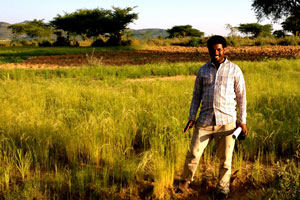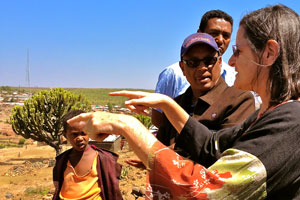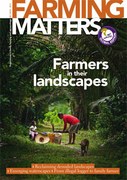This ‘landscape’ issue of Farming Matters comes at a most timely moment. It presents a perfect opportunity to reflect on how agricultural landscape thinking and action has evolved during the past ten years, and the implications of this for the future of family farming.

It is ten years since the first international ecoagriculture conference and practitioners fair was held in Nairobi, and the resulting establishment of EcoAgriculture Partners. Experiences from that meeting also provided much content for a 2004 issue of Farming Matters (then called the LEISA Magazine) on agriculture and biodiversity conservation. At that time, we felt we were at the beginning of a new way of thinking and acting about farming and landscapes that challenged the agriculture mainstream.
A decade later in July 2014, the first conference on Landscapes for People, Food and Nature in Africa took place, also in Nairobi. And what a contrast! Nearly 200 experienced landscape champions from 20 African countries, from the grassroots to the grasstops, were confident enough with advances underway to design an ambitious African Landscape Action Plan to scale up integrated landscape management.
Agricultural landscape thinking in 2004
‘Landscape thinking’ had been around for decades, but was originally focused on achieving mainly environmental goals through large scale forest, habitat or watershed conservation. Increasing agricultural production or farmer incomes was rarely an objective, and many landscape programmes even sought to limit farming. In 2004, there was still considerable conflict between the agriculture and environmental communities, and the relationship was framed as an unavoidable trade-off, an ‘either/or’ marked by distrust and fights over the designation of land use priorities.
We coined the word ‘ecoagriculture’ in 2001 to describe the management of mosaic landscapes including farms and protected areas, with the aims of jointly enhancing agricultural production, biodiversity (of both cultivated and wild species), ecosystem conservation, and local livelihoods. LEISA Magazine in December 2004 highlighted diverse examples of this from all over the world.
For the most part, these innovations and adaptations to indigenous practices were being implemented at small landscape scales, and were rarely part of government policy or development programmes. Data on the many benefits of these approaches was still limited and analysis was in any case a challenge.
From thoughts to action
But away from the public eye, innovation was happening everywhere, as practitioners and researchers sought to find synergies between farming and conservation. Much of the world’s agricultural land is in areas that are also critically important for water resources, wild biodiversity conservation or climate change adaptation and mitigation.
The dependence of agricultural production and sustainability on healthy ecosystems was becoming increasingly recognised. As so many different people live in any single landscape and must share the same resource base, negotiating acceptable agreements among them is essential.
During the past decade, many initiatives that focused on specific ‘sectors’ such as water management, biodiversity conservation, land restoration or agricultural development, evolved to promote multifunctional landscapes that meet the needs of diverse stakeholders.
Although more than 80 terms have been used by different people to describe aspects of integrated landscape management, in 2013, the Landscapes for People, Food and Nature initiative agreed on a working definition. Such management involves long term collaboration among different groups of land managers and stakeholders in order to achieve their multiple objectives and expectations within the landscape regarding local livelihoods, health and well being. Integrated landscape management encompasses agriculture, ecosystem services, biodiversity, aesthetic landscape value, cultural identity and recreational values as well as human settlements and resource extraction industries. In seeking complementary solutions to common problems, they pursue new opportunities through technical, ecological, market, social and policy means.
As landscapes are complex socio-ecological systems, accepting dynamism and change must be inherent in their management. There are many different approaches to integrated landscape management, with different entry points, processes and institutional arrangements. Most include features of conflict management, an understanding of democratic rights, broad stakeholder participation, negotiation based on common objectives and strategies, adaptive management based on shared learning, and sustainability as a goal for human needs and ecosystem health.
Family farmers in landscape management

Family farmers are clearly critical stakeholders within agricultural landscapes, given the reliance of their multi-faceted livelihoods on diverse landscape features for resilience, and stewardship of resources under their management.
A recent survey documented 104 integrated landscape initiatives in Latin America and 87 in Africa. Of these, more than 80% had producer organisations as key stakeholders, and more than 40% included indigenous peoples’ organisations. However, although family farmers are involved in landscape initiatives, their roles are often restricted to being the object of actions designed by others, or they may even be defined as the ‘problem’. This can be due to their use of farming and land use practices that are perceived by some as detrimental to the interests of other stakeholders.
Weak farmer organisations and inadequate access to information also limit their ability to engage equitably in decision-making processes. This is particularly common in landscape initiatives led and funded by state or national government agencies, national or international NGOs, regional programmes such as transboundary conservation or watershed projects, or the private sector. Resolving the large power imbalances between different stakeholders remains a major challenge, and politically marginalised groups including women struggle to have their voices heard.
But some examples of integrated landscape management have been driven and largely managed by family farmers or by farming, pastoral and forest communities, such as those seen in the pages of this magazine. Many groups that first organised to protect or restore land and forest rights have evolved to address collective challenges of land and resource management.
Networks are emerging, such as International Landcare that support dozens of locally-organised landscape initiatives in Asia and Africa, and the international Model Forest Network that supports long term multi-stakeholder initiatives in 58 landscapes in the Americas, Africa, Asia and Europe. Together, these all suggest that producer movements have a pivotal role to play in developing, scaling up and managing increased farm production, ecosystem benefits, and in implementing multi-stakeholder planning.
Growing interest
As experience in integrated land management grew sharply in the last ten years, so did policy interest in the approach. Those involved in agriculture, environment and rural development lost confidence in the efficacy of fragmented sectoral strategies to deliver sustainable outcomes. Scientific evidence and practical experience showed that the challenges of climate change and food security required action in agriculture beyond improved seed and more fertilizers and beyond the farm scale.
Biodiversity experts began to recognise the importance of cultivated and grazing land in the conservation of wild species. And it became increasingly clear that improving the well being of family farmers would enhance their capacity for land stewardship and landscape resilience.
Although this approach is by no means dominant, it has at least become ‘respectable’. Mainstream institutions like the World Bank, CGIAR and NEPAD now have landscape programmes. Many countries have set up national initiatives or policies to support or invest in integrated landscape management, from Australia and Indonesia to Burkina Faso and Zambia. Some multinational companies are collaborating in integrated landscape initiatives to manage their reputation and sourcing risks, and impact investors are now setting up landscape investment funds.
This increasing interest and investment in landscape approaches can be of great value for family farmers. They can support more sustainable agroecosystems, create new partnerships, new market opportunities, and incorporate the conservation of cultural values.
Multi-stakeholder landscape initiatives can provide a platform for dialogue and advocacy around land and resource rights and alternative agricultural investment strategies in the face of fast-paced agro-industrial development. But the quality of landscape governance is highly variable, and there are many potential threats and challenges for family farmers involved in such initiatives.
Many have decision-making processes that marginalise family farmers and their role in reaching agricultural production objectives is not adequately acknowledged. Proposed interventions for environmental objectives are not co-designed with the farmers who are best placed to look after the landscape.
Empowering family farmers
So how can family farmers and their organisations position themselves during the next decade to realise the benefits from more integrated landscape management and investment? Firstly, farmers need to ‘step up to the plate’ in taking up leadership roles in these initiatives, and find ways to collaborate more effectively. They must bring the smallholder agriculture agenda more centrally into what has until recently been a more conservation-led approach. And farmer organisations should ensure representation of the interests and needs of all, including marginal farmers, during the negotiations that follow.
The outcomes depend upon how organisations frame their own values and goals in including farm and landscape stewardship, how they fight for the political space to engage meaningfully in multi-stakeholder processes, and how they proactively explore partnerships with other interest groups in their own landscapes.
The contributors to the 2014 African Landscape Action Plan in Nairobi defined several priority actions specifically related to family farmers and their communities. They encouraged policies that would recognise traditional land management systems, better link grassroots land managers and national policies, and improve the level and quality of community involvement in policy decisions and public accountability. They also argued for more explicit methods to address the imbalanced power relations in landscape governance. They recommended greater use of market mechanisms that benefit small and medium sized enterprises, and to provide investment in appropriate microfinance initiatives. They supported further strengthening in the capacity of farmers and their communities to plan and implement integrated landscape strategies, as well as greater youth engagement.
What should we work towards in the next ten years?
Local interests in land and resource planning can be strengthened by building engagement with family farmers into integrated landscape initiatives from the outset. Farmer federations, cooperatives and other organisations must become key players in these initiatives, and proactively develop strategies and capacities to do so. Where such multi-stakeholder platforms for landscape management do not yet exist, family farmer organisations should take the lead, developing their own capacities, engaging with new partners, committing to working collaboratively for land stewardship, and ensuring that they are not marginalised from future efforts. May the stories in this issue provide inspiration.
Sara J. Scherr
Sara J. Scherr is President of EcoAgriculture Partners, and Chair of the Landscapes for People, Food and Nature Initiative. Email: sscherr@ecoagriculture.org (http://landscapes.ecoagriculture.org)

